

Who discovered America?
|
Native Americans |
Answer: If is probably fair to say that everyone above helped to discover the New World. During the Great Age of Exploration in the 1500's and 1600's, many explorers and adventurers came to our area of the world for many different reasons, and they all helped to discover a little bit more and more about the continents of North and South America.
Why did all these people come to the New World?
|
They followed the animals they were hunting. They came to claim land and power for their country. |
Answer: People came to the New World for all the reasons listed above. But what is really important is that all these people did come, and they inspired more and more people to come, to explore, and to settle. Even though no one ever found the Northwest Passage to the Indies that they were looking for, their searches brought Europeans from many countries to the western hemisphere. This led to the creation and growth of settlements here.
What do you think the term Northwest Passage means? This link may help you.
|
Why did people explore by ship? |
|
|
Unless there were good roads, it was often easier to travel by boat. Merchants, people who buy and sell goods for a living, also needed to find a sea route to the East where spices grew. Spices used to be brought to Europe by a land route, but after the Muslim Turks took over Istanbul ( Constantinople) in the mid 1400's, they blocked the passageway from the eastern Mediterranean area into Europe because they did not want to trade with Christians. As a result, the price of goods coming from the East kept getting higher because the trip was getting longer and more difficult. |
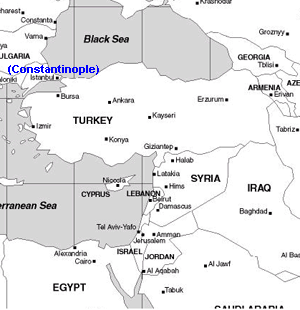 |
|
Look at the map below. |
|
Why did people need spices?
Spices were a luxury. They were used to disguise the taste of salted meat in winter. Before people could grow enough food to feed animals (fodder) in winter, all animals had to be killed at the beginning of cold weather and the meat preserved. Salting was the only way people could keep meat from spoiling. Rich people also used spices to make medicines.
What are some reasons people of long ago wanted spices?
Which country led the way?
Portugal. The Portuguese capital, Lisbon, had a good harbor and was well placed for voyaging down the west coast of Africa. From about 1418, Prince Henry urged sailors to make these voyages to the south. He set up a school where seamen could learn about navigation (how to find their way at sea). He became known as 'Prince Henry the Navigator'.
Find Lisbon, Portugal, on the map below.

Now find Portugal on this map.
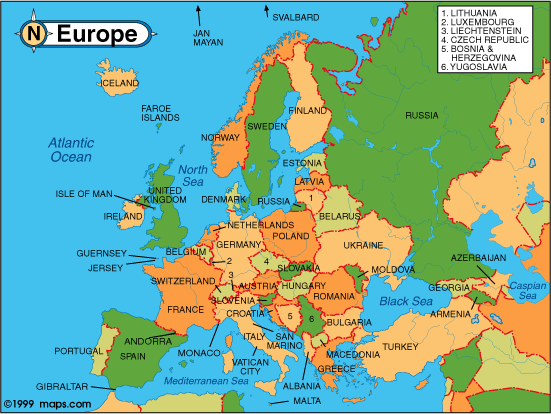
How would you travel by ship from Portugal to the Indies? Look at the map below to answer the question.
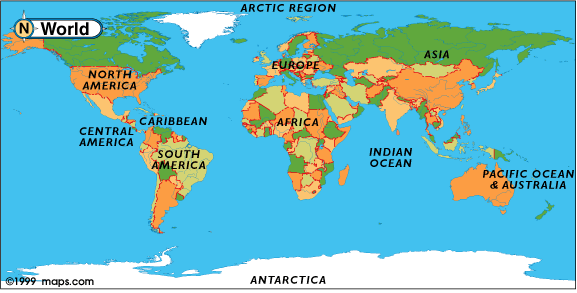
Why did Prince Henry want sailors to explore?
He hoped to make Portugal rich. He hoped men would find gold, silver and new places to sell Portuguese goods. He also hoped to convert people from other countries to Christianity.
Why were sailors afraid to go far by sea?
They were afraid of the unknown. They hadn't sailed far down the west coast of Africa before. Legends said that at the Equator the sea boiled, and that there were huge sea monsters which ate ships and crunched them up like biscuits.
What ships did the Portuguese use?
Caravels. These were fast, handy boats and good for sailing along coasts in the Atlantic. They were quite small.
Who first sailed round Africa?
The first person to sail around the bottom of Africa into the Indian Ocean was a Portuguese captain called Bartolomeo Dias. He set off in 1487 with three ships. He was caught in a terrible storm at the southern tip of Africa and so called it the 'The Cape of Storms'. Later, the king of Portugal changed this name to 'Cape of Good Hope' because he thought there was now a strong hope of finding a sea route to India.
Who was Vasco da Gama?
He was a Portuguese sailor and the first person to sail from Europe to India. He left Lisbon in 1497 with four ships to see if he could get further than Bartolomeo Dias. Once he rounded Africa, he found Arabs trading in the Indian Ocean and was able to get someone to guide him across to India. He returned to Portugal after two years with a cargo of spices and gems.
Did Da Gama have an easy voyage?
No. He lost two ships and almost half his men. Most died from illness, especially scurvy. Scurvy is an illness caused by lack of vitamin C. Vitamin C is found in fresh vegetables and fruit. Sailors on long voyages lived mostly on salted meat and ships' biscuit (a very hard, dry biscuit made of flour, salt and water). By the end of the voyage, these biscuits would be full of black insects called weevils. They had no fresh food for weeks at a time. They were all afraid of scurvy. Scurvy makes the gums swell and the teeth fall out. There is bleeding beneath the skin and wounds do not heal. Europeans at that time did not know how to prevent scurvy. Doctors had not then discovered vitamins. And the lack of fresh water was another serious problem, too.
What was life like on board?
Ships were damp and soon became filthy because they were hard to clean. There were many rats on board. Foul smells came from the bottom of the ship, where stagnant water mingled with the ballast, the sand and stones which weighted the ship and kept her steady. Men fell ill from exposure and often had to wear wet clothes. No wonder so many died from disease.
Was the suffering of the crews worth it?
Vasco da Gama and his men suffered on the long voyage to and from India, but the cargo they brought back was so valuable that the trip made a profit of almost 6000 per cent. Vasco da Gama had proved that people could reach India by sea and had opened up a new trade route.
Questions:
1. What is ballast?
2. Name 2 other species of living things on board Vasco da Gama's ships, other than human beings.
3. What do you think was the worst part of being on one of these ships?
4. If the conditions were so terrible on these ships, why do you think men agreed to sail along with these explorers?
5. Why do you think you do not know of anyone today who has scurvy?
6. What cargo did Vasco da Gama load his ship with on his return voyage back to Portugal?
Columbus completed several round trips to North America?
Did he think that he had made it to the Indies?
Yes, Columbus died thinking that he had found a quick route to the Indies. In 1502, an Italian explorer named Amerigo Vespucci convinced Europeans that the land Columbus had visited was not part of the Indies, but actually a new land. North and South America were named after him.
What happened next?
News of the New World spread. Gradually, more and more people set sail from Europe, curious to explore this unknown land. Many hoped to possibly find a passage through this area to get to the spices in the Indies. Some were looking for gold, silver, and precious stones. Others wanted to spread their religion. Many, especially the French, wanted to make money selling animal furs. And many nations wanted to have more power by controlling more land.
1. John Cabot was sent by the king of England. In 1497, he was the first to hunt for a northwest passage. What he discovered was an area in Canada that was full of fish. He called it Newfoundland. Sailors started to come to fish there. He claimed the land for England.
2. Champlain was sent by the king of France. France did not want to be left out of the race to claim land and riches or discover trade routes. Champlain explored the St. Lawrence River. He built a fortress there in 1608. That became the city of Quebec. He also traded with the Indians. They gave him animal furs, and Champlain gave them tools, cloth, and beads. Lake Champlain is named after him.
3. Henry Hudson explored for the Netherlands and for England. The Hudson River area was claimed by the Dutch in 1611. New York City was named New Amsterdam back then because Amsterdam was the name of the most important Dutch city. Hudson later sailed for England. The Hudson Bay area was named for him.
4. Coronado searched for gold in the southwestern part of the United States. He was looking for the legendary 7 cities of gold, but he never found them. But when he went back to Spain in 1542, the king of Spain claimed the Southwest of the United States for Spain.
5. Hernando de Soto was also looking for the 7 cities of gold. He went to the Florida area and then traveled around the Southeast. What he did find was the Mississippi River in 1541. The king of Spain claimed that area, too.
6. Father Marquette and Jolliet were French explorers who discovered the Mississippi River in 1673. Marquette was also a missionary, trying to spread Christianity to the Indians. Jolliet was a fur trader in New France. At first they thought that the Mississippi might lead him to the Pacific Ocean, but it did not. They did not travel all the way down to the Gulf of Mexico. They turned back because of a warning from friendly Indians.
7. Cartier was sent to find a northwest passage by the French king in 1531. He found the mouth of the St. Lawrence River. He made three voyages of exploration to North America along the coast of Canada and the St. Lawrence River. These trips gave France the reason to claim land in this area.
8. Cortez was a Spanish conqueror. He attacked and defeated the Aztec Empire in 1520. They were ruled by Montezuma. To this day, Montezuma is still trying to get revenge on outsiders coming into Mexico! Go here and here to find out what Montezuma's revenge is.
9. Magellan led an expedition around the world searching for a shorter sea route to the Indies. He was a Portuguese sailor who was sponsored by Spain. But he couldn't get Spanish sailors to go with him, because he was not Spanish. The king released criminals from jail to go with him! Magellan traveled west in 1519 to try to find a passage through South America, but he ended up going around the southern tip of the continent. He never completed the trip around the world himself, but 18 men in his crew of 250 did. Trace Magellan's route on the map below.
Click here to test your knowledge of the explorers mentioned.
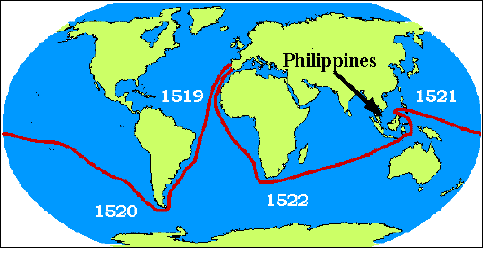
Learn more about these explorers, and others:
Either click their linked names, or go to these biography sites:
Infoplease Biography - Biographical Dictionary - Biography.com
| Cabot | Vespucci | Balboa |
Ponce de Leon |
Cortez | Magellan |
| La Salle | Coronado | Cartier | Father Marquette | Jolliet | de Soto |
| Columbus | Ericson | Lewis & Clark | Hudson | Cartier | Drake |
| Prince Henry the Navigator | Marco Polo | Dias | Giovanni Da Verrazano | Pizarro | Cabeza De Vaca |
| Champlain | La Salle |
More Spanish came to New Spain, the area of the United States claimed by Spain. But they did not all come to find gold. Many were missionaries. They came to convert the Indians to the Catholic religion. They built missions, or churches, all the way from Texas to California. Priests worked in the missions and taught the Indians many things, but the Indians wanted to live with their own people. They left these missions, and many of them had to close down. But others became very large and eventually became towns, like Santa Fe.
Here is a map that shows the areas in North America that were claimed by the Spanish.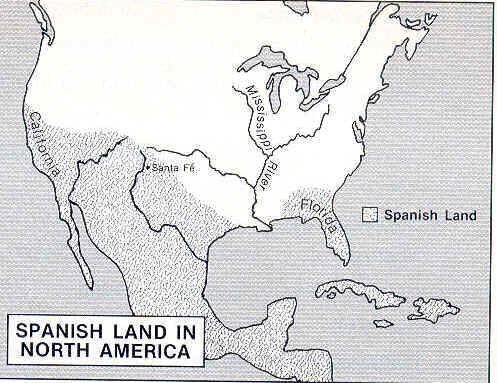
After the explorers......
The Spanish came to New Spain. As you can see from the map above, New Spain consisted of the islands in the Caribbean Sea, Mexico, Florida, and the states from Texas to California.
More people came from many countries. They came for many reasons, especially for land and riches. The French settled New France, in eastern Canada. The English settled New England and Virginia. The people who came here were called settlers, or colonists.
One more early group that came to the new world must be mentioned here. They were the Africans. But they did not come for land or riches. They did not want to come. They were brought here by the Europeans as slaves. They needed people to work for them, especially on their farms.
Activities:
Copy and paste this map into Paint. Label the following:
Hudson Bay - Atlantic Ocean - Gulf of Mexico - Caribbean Sea - Pacific Ocean - Arctic Ocean - Bering Strait
Then...use this map below to add the areas explored by different countries and people. Make a legend to go with it.